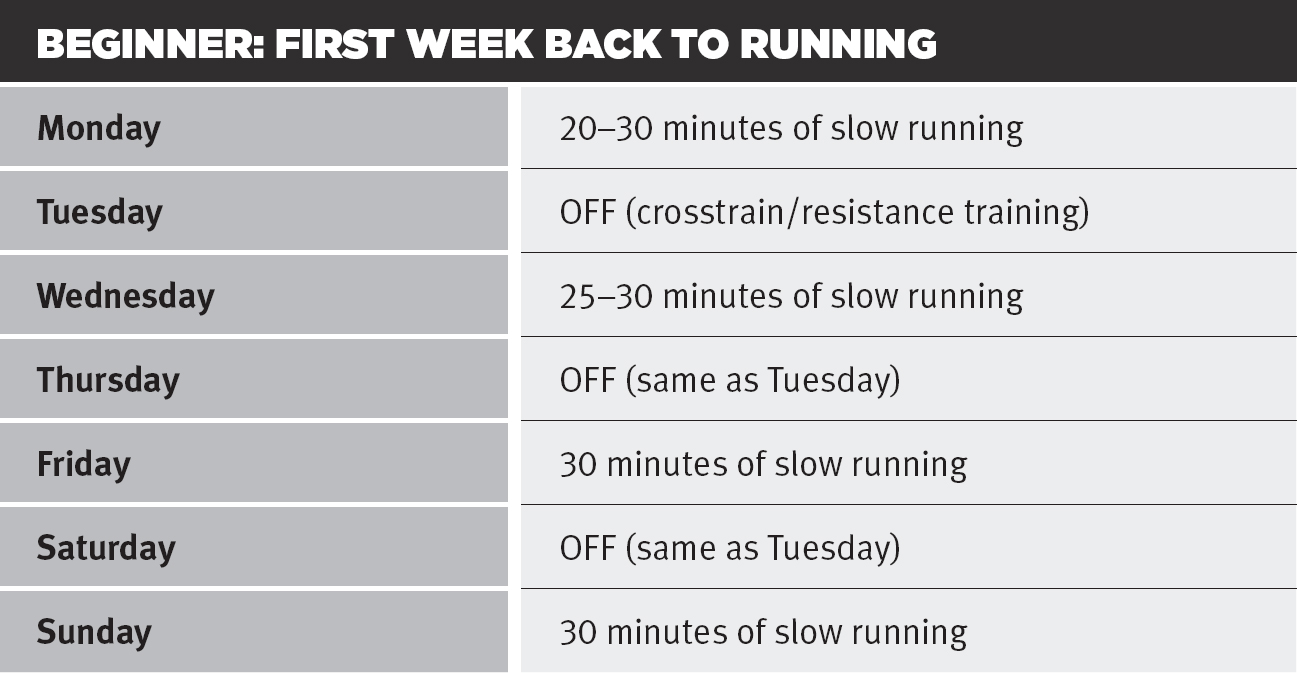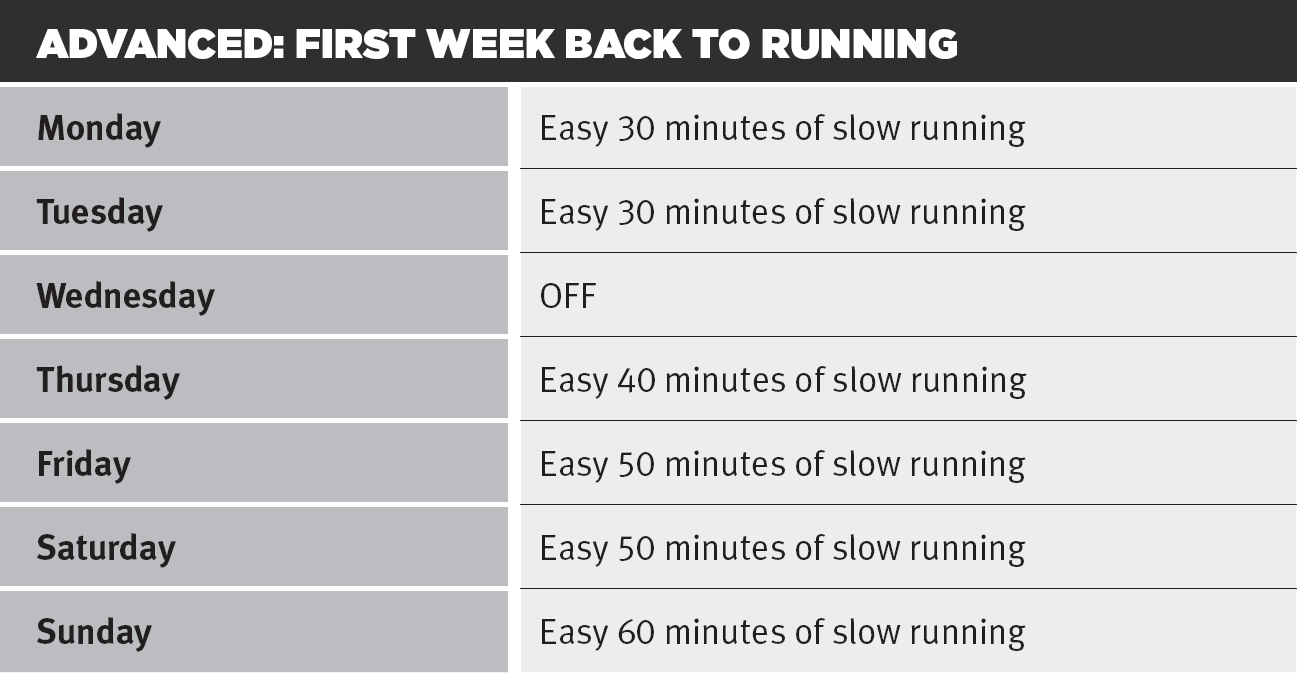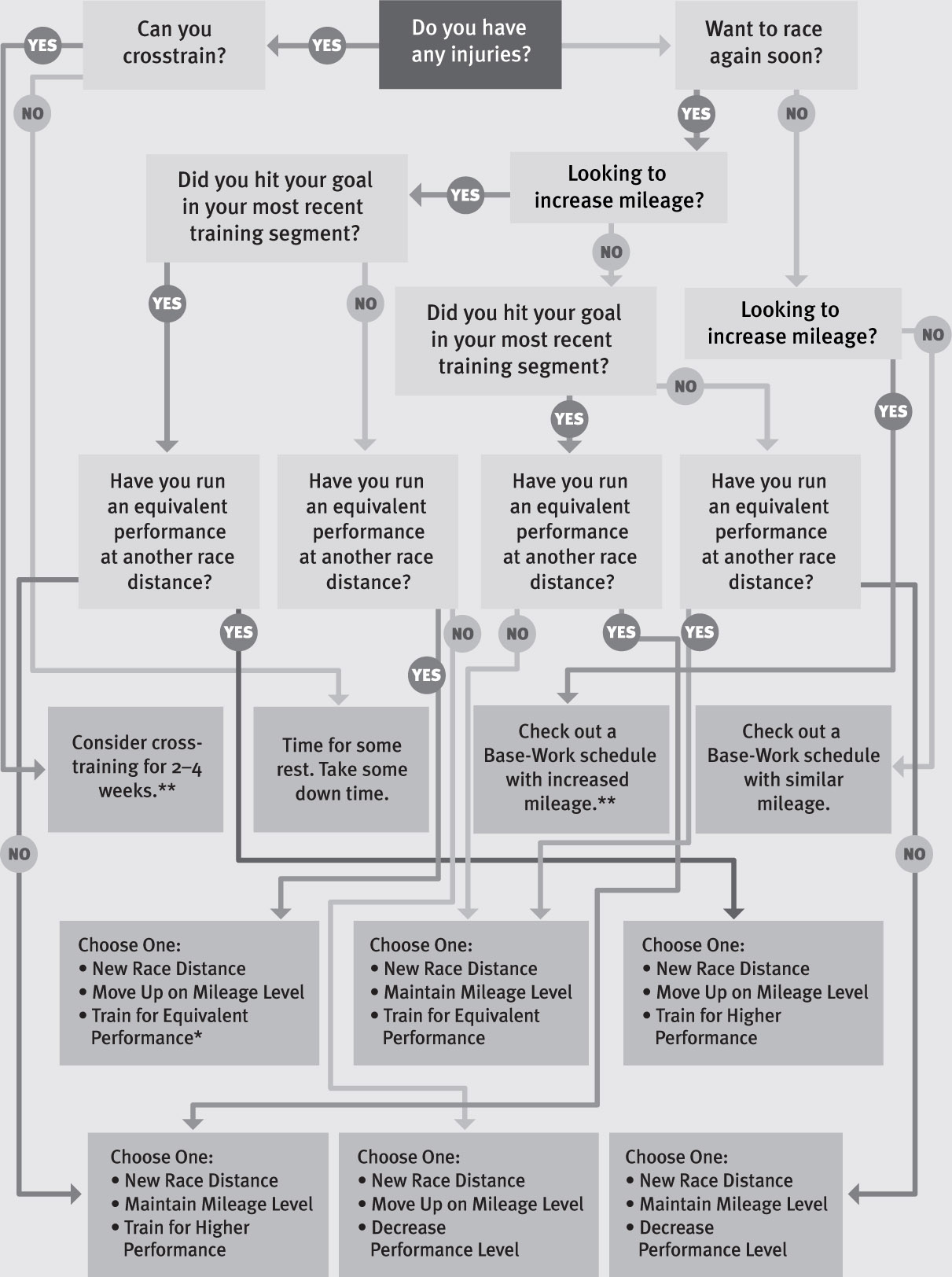
FOR THE HANSONS-BROOKS DISTANCE PROJECT team, two weeks of no running is the cardinal rule after a marathon. When I first joined the team, it was 10 days; however, Kevin and Keith found that wasn’t quite long enough. Regardless of whether you met your goals or fell short, you need to take a couple weeks of down time. When you cross that finish line, it’s like a racecar driver praying that there’s just enough fuel to take him past the checkered flags. While you’ll be fueling and hydrating throughout the race, there is no way to keep your stores topped off. By the time the finish line is in sight, you’re probably running on empty. Taking a break from running after the marathon is important because it gives your body time to bring glycogen and hydration levels back to normal.
In addition to being depleted of all fuel sources, your exercising muscles also feel the burn. I have run 10 marathons, ranging from 2:14 to 2:20, and the pain the following day is always the same. I’m stiff, sore, and supremely worn out. The marathon breaks down your muscles on a microscopic level, leaving them in dire need of time for rest and repair.
By taking a couple weeks of rest, you’ll ensure that you’ll be healthy and prepared for your next endeavor. Consider the following your plan of action as soon as you cross that finish line.
IMMEDIATELY POST-RACE
It often happens that a runner reaches the finish line and then wonders, “Okay, now what?” We spend so much time focusing on training that it’s easy to forget to plan for what comes after you finish your 26.2-mile goal. No matter what the clock says, as long as you gave the race your best shot, you can count your marathon a success. So first, take a few moments after the race to revel in the fact that you took your body to the edge and made it to the finish. Allow yourself a moment to be proud of this major accomplishment. Along with those positive feelings will most certainly come soreness and exhaustion. I remember standing in the finishing chute after my first marathon thinking, “There is no way I will ever do that again.” That was 10 marathons ago. Sure it can hurt, but after that first race, many marathoners are hooked.
FIRST 30 MINUTES
The same general rules you follow post-workout apply post-marathon. While you may wince at the thought of eating, you need to try to consume some calories right away. The good news is that you can pretty much eat anything you are craving. One of my teammates always wants a bowl of chicken broth, while my wife absolutely has to have a Coke. Personally, I am partial to chocolate chip cookies. At this point, it is the calories that are important, not the source from which they are coming. This is a good thing because you usually can’t be picky when it comes to finish-line fare. Whatever they are offering, take it. Since you have depleted nearly all of your available muscle and liver glycogen, your body will bounce back far sooner if you do. What’s more, your blood glucose is low, you’re dehydrated, and you have only a few remaining electrolytes. The faster you start replacing these nutrients, the sooner you’ll be back to feeling normal. That window of optimal recovery time is short, so take advantage of the goodies in the finish chute during those first 30 minutes after the race.
THE FIRST 2 HOURS
Once you gather your hardware and snacks, you can leave the finish chute and find your family and friends. As long as you have had something to eat and drink, you don’t need to worry about consuming a full meal until your stomach settles down. If it isn’t a hometown race, go back to your hotel, get cleaned up, and put on some comfortable clothes (and shoes!). By that point you may be ready to sit down for lunch. Although you are probably tired of pasta, focus on taking in a high percentage of carbohydrates to replace all of that lost glycogen. If you still aren’t ready for a feast, steadily consume calories to get in a good amount over time. At this point, try to choose more nutritious snacks to get your system back on track. Fruits, vegetables, and whole grains are all great options for food, along with water, fruit juice, or sports drinks.
THE REST OF THE DAY
Continue to hydrate and replace calories as desired. Put your feet up and relax for a few hours; no one will argue that you don’t deserve it. Although I’m always stiff and tired, I like to get up and walk around later in the evening to loosen up my legs. As you probably know from talking to anyone who has finished a marathon, mobility can be tricky for the next couple of days. Those first steps out of bed the following morning will be labored, and walking up and down stairs may seem a challenge akin to climbing Mount Everest. From elites to weekend warriors, no one escapes a marathon without at least a little soreness. Besides the glycogen depletion, the structural integrity of the muscles has been compromised, so don’t plan any big outings right after the marathon. In my experience, the first marathon dishes out the most difficult recovery. The more you run over time, however, the easier recovery seems. After my first marathon it took nearly two months before I felt back to normal. Today, however, I feel 100 percent after only a few days.
THE NEXT 3–5 DAYS
Don’t run at all during this period of time. Just focus on navigating stairs and getting through the workday without too much trouble. We have learned that taking a break from running is generally very beneficial. Not only should you not run, but also you should take time away from putting any other races on the calendar. Some runners fall into a cycle of jumping back into mileage just a few days after the marathon, often leaving their legs feeling stale a month or two down the line. Instead, take the time off now, recover completely, and then go back to running. Use this time to catch up on the things that took a backseat during training and enjoy the break. Instead of worrying about your next workout or fitting in your long run, you can sleep in, read the newspaper, and regain some balance in your life.
THE NEXT 2 WEEKS
Many runners dislike taking a few weeks off training, worrying they might lose precious fitness. It’s important, however, to understand how a break fits into the bigger picture of training. A planned break most certainly can prevent a forced break due to injury or overtraining. You are better off allowing yourself the time off now, even though it feels like a major deviation from the routine you established over the past few months. Some people will take the entire two weeks away from exercise altogether; others will incorporate some crosstraining. Either option is fine, as long as the crosstraining isn’t too intense. A light resistance training program or a cycling regimen is a reasonable choice. The benefit of jumping into crosstraining is that it helps to maintain the routine you worked so hard to build, making it easier to resume running again. The bottom line is to refrain from running for these two weeks to let your body completely recover before getting out and pounding the pavement again.
Following your two-week vacation, it’s time to start running again. If you’re a first-time marathon finisher, we don’t want to put a timeline on your return, other than to advise you to be cautious. Most veterans are itching to get running again after a fortnight of rest. While we love to see this enthusiasm, one of the problems we often encounter is that some runners want to begin planning their next race before they are even two weeks out from the marathon. It is good to have goals, and we are always glad that a runner wants to continue training, but make sure you are flexible with these plans. For both newbies and veterans alike, it is important to wait and see how recovery goes in order to avoid rushing back to running too soon.
Getting Back to Your Routine
Once you have established that you’re fully recovered and ready to get back into your routine, we advise starting with an easy running regimen. Upon your return, those first few runs may feel stiff and more difficult than usual. Don’t worry: You haven’t lost as much ground as you think. Two weeks off will have decreased your fitness by about 5 percent, a small number at this point in the training cycle. For new runners, try starting with about 30 minutes every other day. The first week might look like this:

Veteran runners can be more aggressive in their return, but their effort should still be based on how the body reacts to the return to training. An experienced runner’s body is probably more accustomed to marathon training, making the comeback somewhat easier. Even so, every runner is different, and you should be cognizant of what your body is telling you after the marathon. A sample week for a veteran runner returning to running might look like this:

For all runners, resistance training can be resumed, two or three times each week. This should be done on days that you won’t be doing SOS workouts in the upcoming weeks, allowing you to get into a routine. For example, if you know that in the future you’ll be doing SOS workouts on Tuesday, Thursday, and Sunday, establish your resistance-training days on Monday, Wednesday, and/or Friday. By starting the regimen at this time, you can build running-specific strength without doing a single workout for several weeks.
After following the aforementioned mileage for the first week back to training, you might consider bringing things up a notch for the second week, although it should still be all easy mileage. This depends on how your body responded to that first week. If you are feeling refreshed and looking forward to getting back on track, add a bit of mileage. The beginner should add two days with 30-minute runs, bringing the weekly total to five days of 30-minute runs each. Advanced runners can add time to each of their running days, aiming for 45–60 minutes of easy running, six days a week. If you are still feeling sore and tired, however, give yourself another week to linger at the lower mileage and let your body and mind recover.
4 TO 6 WEEKS POST-MARATHON
After those first two weeks of easy running, you should spend the next two weeks building mileage, allowing for a slow return to typical training volume. The Advanced Program peaks at 60–70 miles, but the average mileage is between 35 and 45 miles per week and the Beginner Program is slightly less, at 30–35 miles per week on average. Once you are comfortably running “average” weekly mileage again, you can begin structured training and start to draw up plans for new goal races or more general ambitions. Whatever it is you choose to do, a training segment doesn’t always need to adhere to an 18-week time frame. You may find that as you become more experienced, the length of time you need to prepare for a marathon can be shortened by a few weeks. In most cases, a speed or base-building segment can be 10–14 weeks. The more weekly mileage a person is able to tolerate, the shorter those training segments often need to be.
THE GREAT BEYOND
The question at this point is where to go from here. Many runners feel they need to get right back into marathon training, although this isn’t the optimal choice for a lot of runners. Case in point, we limit the runners in our Elite Program to three marathons in two years. If you just completed a fall marathon, it might be a good idea to build a strong base before entering training for a spring marathon. This is a sensible plan if you qualified for Boston or have another spring marathon in mind. That gap of time from November through January is great for base fitness running, especially since it tends to be a time of year that includes holiday plans and family obligations. For runners who just completed the Beginner or Just Finish Programs, this can be an ideal time to build up mileage and perhaps gradually enter a more ambitious training regimen for the spring marathon. This time gives you the chance to safely and slowly put mileage on your legs, preparing you for the increased training.
Some runners decide to capitalize on the fitness base they have just built by dedicating a training segment to shorter races. From 5Ks to the half-marathon, this is a great way to build speed and keep your legs feeling fresh, rather than simply going right back into long marathon training. Many of the runners we work with are stuck in a marathon rut and simply need to take a step back and work on some of the types of training they abandoned long ago. Sure it’s nice to be at ease with the marathon distance, but sometimes it is beneficial to break out of your comfort zone. A 10-week speed section is especially beneficial for runners who have just finished a spring marathon but want to do a fall marathon as well. After two weeks off, they can focus on shorter races for a couple of months and then go straight back into marathon training. After a speed-focused season of training, runners inevitably feel fresher, faster, and ready for a breakthrough at 26.2.
Assessing Race Success and Determining Future Direction
Every training cycle, regardless of the race-day result, contains value for an athlete. Identifying patterns of success and failure are crucial to long-term success. Hopefully, race day brings a nice payout for your hard work, but sometimes it doesn’t. Either way, it is important to review the training cycle as a whole, and try to find the components that increased fitness and those that inhibited it. Good questions to ask after a training cycle include:

![]() Was I able to complete all of the training as scheduled? If not, did I run more than scheduled or less?
Was I able to complete all of the training as scheduled? If not, did I run more than scheduled or less?

![]() Was I able to hit all the prescribed workout paces? If not, were there specific workout types that gave me trouble?
Was I able to hit all the prescribed workout paces? If not, were there specific workout types that gave me trouble?

![]() Did I run any of the workouts, easy days, or long runs faster than prescribed?
Did I run any of the workouts, easy days, or long runs faster than prescribed?

![]() Was this training cycle at a higher level of weekly mileage than usual? Higher than I’ve ever done?
Was this training cycle at a higher level of weekly mileage than usual? Higher than I’ve ever done?

![]() Was the goal pace faster than I’ve ever run? Was goal pace too aggressive?
Was the goal pace faster than I’ve ever run? Was goal pace too aggressive?

![]() Were my goals appropriate relative to recent performances and fitness?
Were my goals appropriate relative to recent performances and fitness?

![]() What was my pre-race routine like compared to past cycles?
What was my pre-race routine like compared to past cycles?

![]() How well did I execute my race plan? Did I start too fast? Too slow?
How well did I execute my race plan? Did I start too fast? Too slow?

![]() Did I have people to race? Was the crowd support good?
Did I have people to race? Was the crowd support good?

![]() What was going on in my life during this training cycle?
What was going on in my life during this training cycle?

![]() Was my life more stressful or less stressful than past training cycles?
Was my life more stressful or less stressful than past training cycles?

![]() Did I get sick during this training cycle?
Did I get sick during this training cycle?

![]() Was I dealing with any injuries this training cycle?
Was I dealing with any injuries this training cycle?

![]() What was my sleep like this training cycle?
What was my sleep like this training cycle?

![]() What was the weather like this training cycle? Did I adjust for weather?
What was the weather like this training cycle? Did I adjust for weather?
The goal is to look for parameters that correlate with success and failure. From there you work to incorporate those associated with success and mindfully eliminate or adjust those that seem to factor in failure. Teasing apart the factors related to both will allow you to progress through higher levels of fitness more quickly than those who do not do so.
Once you’ve identified some success and failure factors, where do you go next? First, take your scheduled downtime as outlined earlier in the chapter. This is especially important if you’re carrying any injuries or excess fatigue. After this well-deserved downtime, thoughtfully consider your options. Need help deciding? Check out the decision tree in Figure 12.1.

*“Train for equivalent performance” means focus on shorter distances. For example, if you want to break 3 hours in the marathon but haven’t broken 1:30 in the half-marathon, consider a training cycle to work on bringing your half-marathon time down to an equivalent 3-hour marathon performance before going back to attempt that marathon goal time.
**The Hansons base-building and crosstraining programs can be found at www.hansonscoachingservices.com.